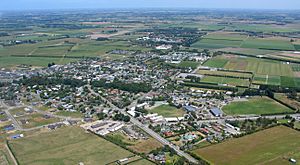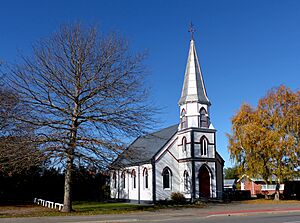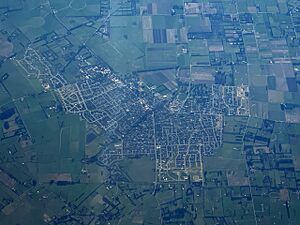Lincoln, New Zealand facts for kids
Quick facts for kids
Lincoln
|
|
|---|---|
|
Minor urban area
|
|

Looking southwest across Lincoln from the air, December 2005
|
|
| Country | New Zealand |
| Island | South Island |
| Region | Canterbury |
| Territorial authority | Selwyn District |
| Ward | Springs |
| Electorates |
|
| Area | |
| • Total | 9.90 km2 (3.82 sq mi) |
| Elevation | 10 m (30 ft) |
| Population
(June 2023)
|
|
| • Total | 10,250 |
| • Density | 1,035.4/km2 (2,681.6/sq mi) |
| Time zone | UTC+12 (NZST) |
| • Summer (DST) | UTC+13 (NZDT) |
| Postcode |
7608
|
| Local iwi | Ngāi Tahu |
Lincoln (which is Rīkona in Māori) is a town in the Selwyn District. It is located in the Canterbury Region of New Zealand's South Island. The town sits on the Canterbury Plains, about 22 kilometres southwest of Christchurch.
Lincoln is the second largest town in the Selwyn District. Only Rolleston is bigger. Many people who live in Lincoln also work in Christchurch. Lincoln is also home to Lincoln University. This university is the oldest agricultural school in the Southern Hemisphere. It is also the smallest of New Zealand's eight universities.
Contents
History of Lincoln
In 1862, a man named James Edward FitzGerald created the town of Lincoln. He named it after the Earl of Lincoln. The Earl was an important person in the Canterbury Association.
Lincoln was planned with a grid of streets. FitzGerald named the main streets after himself: James, Edward, and Gerald. He also named other streets after his children. The town was built near the L1 River. This was a good spot for a flour mill to help local farmers.
By 1873, Lincoln was growing. It had a post office, a butcher, a baker, and a hotel. The town became even busier when the railway arrived in 1875. Another railway line opened in 1886.
The railway lines were very important for Lincoln. One line went to Southbridge. Another line, the Little River Branch, started in Lincoln and went to Little River. In 1962, the railway lines in Lincoln closed. The last part of the railway closed in 1967.
Today, part of the old railway route is a walking and cycling path. It is called the Little River Rail Trail. This trail is very popular for outdoor activities.
In 2021, there was a plan to make Lincoln much bigger. A company wanted to build many new homes on farmland south of the town. This would add about 5400 more people to Lincoln. Some local leaders were against this plan. However, most councillors voted to approve it.
People and Population
Lincoln is considered a small urban area by Statistics New Zealand. It covers about 9.90 square kilometres. The town has an estimated population of 10,250. This means there are about 1035 people living in each square kilometre.
Lincoln's population has grown a lot.
- In 2006, there were 2,820 people.
- By 2013, the population grew to 3,867.
- In 2018, it reached 6,510 people.
This shows a big increase in population over the years. In 2018, there were 2,136 households in Lincoln. There were slightly more females than males. About 20.8% of the people were under 15 years old.
Most people in Lincoln are of European background (84.1%). There are also people from Māori (5.6%), Asian (12.0%), and Pasifika (1.1%) backgrounds. About 27.4% of Lincoln's residents were born outside New Zealand.
When asked about religion, many people (55.5%) said they had no religion. About 33.6% were Christian. Other religions like Hindu, Muslim, and Buddhist were also present.
Many adults in Lincoln have a good education. About 30.2% have a bachelor's degree or higher. Many people in Lincoln also earn good incomes.
Schools and Research in Lincoln
Lincoln has three schools for students.
- Lincoln Primary School teaches students from Year 1 to Year 8. It opened in 1866 and has about 717 students.
- Lincoln High School is for older students, from Year 9 to Year 13. It opened in 1959 and has about 1,430 students.
- Ararira Springs Primary School is the newest primary school. It opened in 2019 and also teaches students from Year 1 to Year 8. It has about 431 students.
Lincoln is also home to Lincoln University. Besides the university, there are many important research places here. These include AgResearch, Institute for Plant and Food Research, and Landcare Research. These places study things like farming and the environment.
Many people work at these research organisations. This makes Lincoln a busy and important place for science. Lincoln also has a hospital for new mothers, a kindergarten, and a golf course.
Lincoln is also home to a special supermarket. The Lincoln New World supermarket uses wind turbines to help power its building. This makes it more environmentally friendly.
Cricket in Lincoln
Lincoln is a very important place for cricket in New Zealand. It is home to the New Zealand Cricket High Performance Centre. This centre is located at Lincoln University.
The High Performance Centre was created in 1995. It helps train New Zealand's best cricketers. The first players started training there just four months later.
There are three cricket grounds at the centre. One of them is the Bert Sutcliffe Oval. This oval has hosted big matches, like the 2000 Women's World Cup. It has also hosted two Under 19 World Cup finals.
Every summer, three national cricket tournaments are held here. These include tournaments for women under 21, men's provincial teams, and men under 18. Many other games and training camps also happen at the centre.
The facilities are excellent. They include six indoor cricket nets, a gym, and places for cricketers to stay. There are also many staff who keep the cricket pitches in great condition. Cricketers can train on grass pitches all year round. In 2018, a special cover and heating system were added. This allows players to train even in winter.
Climate
| Climate data for Lincoln (1991–2020 normals, extremes 1881–present) | |||||||||||||
|---|---|---|---|---|---|---|---|---|---|---|---|---|---|
| Month | Jan | Feb | Mar | Apr | May | Jun | Jul | Aug | Sep | Oct | Nov | Dec | Year |
| Record high °C (°F) | 37.9 (100.2) |
40.4 (104.7) |
34.9 (94.8) |
29.8 (85.6) |
29.7 (85.5) |
22.7 (72.9) |
22.9 (73.2) |
22.3 (72.1) |
26.7 (80.1) |
30.7 (87.3) |
32.8 (91.0) |
36.9 (98.4) |
40.4 (104.7) |
| Mean daily maximum °C (°F) | 22.0 (71.6) |
21.9 (71.4) |
20.1 (68.2) |
17.2 (63.0) |
14.7 (58.5) |
11.7 (53.1) |
11.2 (52.2) |
12.5 (54.5) |
14.8 (58.6) |
16.7 (62.1) |
18.5 (65.3) |
20.5 (68.9) |
16.8 (62.3) |
| Daily mean °C (°F) | 16.8 (62.2) |
16.8 (62.2) |
15.0 (59.0) |
12.3 (54.1) |
9.8 (49.6) |
6.9 (44.4) |
6.4 (43.5) |
7.7 (45.9) |
9.7 (49.5) |
11.6 (52.9) |
13.3 (55.9) |
15.5 (59.9) |
11.8 (53.3) |
| Mean daily minimum °C (°F) | 11.7 (53.1) |
11.7 (53.1) |
9.9 (49.8) |
7.3 (45.1) |
4.8 (40.6) |
2.1 (35.8) |
1.6 (34.9) |
2.9 (37.2) |
4.7 (40.5) |
6.5 (43.7) |
8.1 (46.6) |
10.5 (50.9) |
6.8 (44.3) |
| Record low °C (°F) | −0.7 (30.7) |
−0.3 (31.5) |
−1.9 (28.6) |
−4.4 (24.1) |
−6.3 (20.7) |
−7.3 (18.9) |
−8.5 (16.7) |
−6.9 (19.6) |
−7.2 (19.0) |
−5.9 (21.4) |
−2.7 (27.1) |
−1.2 (29.8) |
−8.5 (16.7) |
| Average rainfall mm (inches) | 42.9 (1.69) |
37.1 (1.46) |
44.2 (1.74) |
54.0 (2.13) |
57.2 (2.25) |
63.9 (2.52) |
52.8 (2.08) |
54.7 (2.15) |
39.3 (1.55) |
46.8 (1.84) |
46.2 (1.82) |
48.8 (1.92) |
587.9 (23.15) |
| Source: NIWA | |||||||||||||




